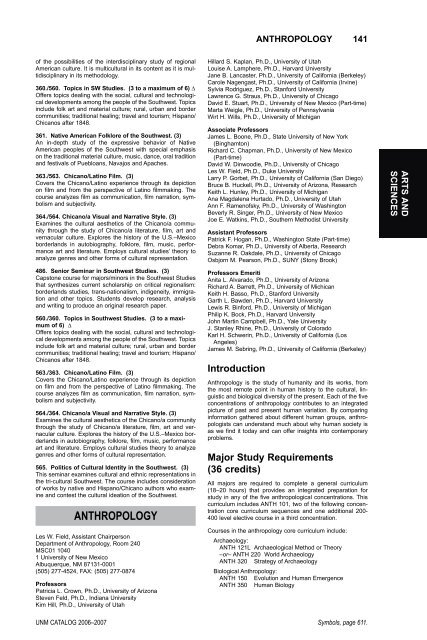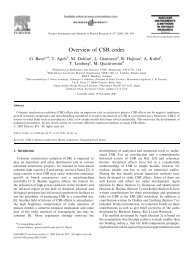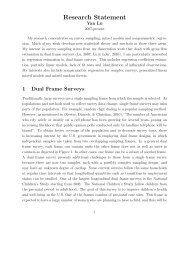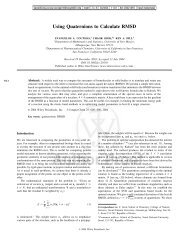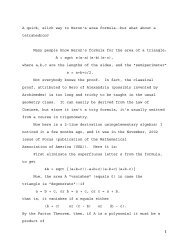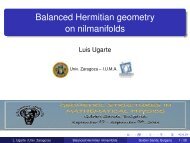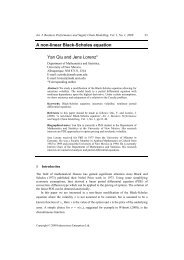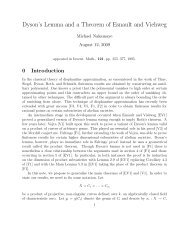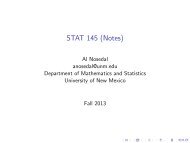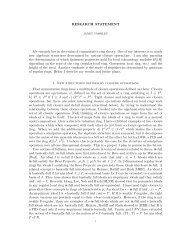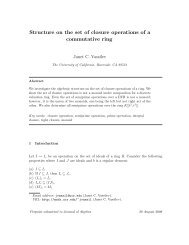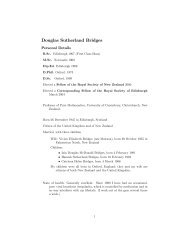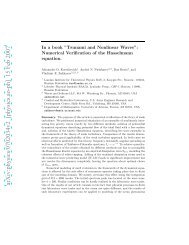OEO Office of Equal Opportunity - Department of Mathematics and ...
OEO Office of Equal Opportunity - Department of Mathematics and ...
OEO Office of Equal Opportunity - Department of Mathematics and ...
You also want an ePaper? Increase the reach of your titles
YUMPU automatically turns print PDFs into web optimized ePapers that Google loves.
ANTHROPOLOGY 141<br />
<strong>of</strong> the possibilities <strong>of</strong> the interdisciplinary study <strong>of</strong> regional<br />
American culture. It is multicultural in its content as it is multidisciplinary<br />
in its methodology.<br />
360./560. Topics in SW Studies. (3 to a maximum <strong>of</strong> 6) ∆<br />
Offers topics dealing with the social, cultural <strong>and</strong> technological<br />
developments among the people <strong>of</strong> the Southwest. Topics<br />
include folk art <strong>and</strong> material culture; rural, urban <strong>and</strong> border<br />
communities; traditional healing; travel <strong>and</strong> tourism; Hispano/<br />
Chicanos after 1848.<br />
361. Native American Folklore <strong>of</strong> the Southwest. (3)<br />
An in-depth study <strong>of</strong> the expressive behavior <strong>of</strong> Native<br />
American peoples <strong>of</strong> the Southwest with special emphasis<br />
on the traditional material culture, music, dance, oral tradition<br />
<strong>and</strong> festivals <strong>of</strong> Puebloans, Navajos <strong>and</strong> Apaches.<br />
363./563. Chicano/Latino Film. (3)<br />
Covers the Chicano/Latino experience through its depiction<br />
on film <strong>and</strong> from the perspective <strong>of</strong> Latino filmmaking. The<br />
course analyzes film as communication, film narration, symbolism<br />
<strong>and</strong> subjectivity.<br />
364./564. Chicano/a Visual <strong>and</strong> Narrative Style. (3)<br />
Examines the cultural aesthetics <strong>of</strong> the Chicano/a community<br />
through the study <strong>of</strong> Chicano/a literature, film, art <strong>and</strong><br />
vernacular culture. Explores the history <strong>of</strong> the U.S.–Mexico<br />
borderl<strong>and</strong>s in autobiography, folklore, film, music, performance<br />
art <strong>and</strong> literature. Employs cultural studies’ theory to<br />
analyze genres <strong>and</strong> other forms <strong>of</strong> cultural representation.<br />
486. Senior Seminar in Southwest Studies. (3)<br />
Capstone course for majors/minors in the Southwest Studies<br />
that synthesizes current scholarship on critical regionalism:<br />
borderl<strong>and</strong>s studies, trans-nationalism, indigeneity, immigration<br />
<strong>and</strong> other topics. Students develop research, analysis<br />
<strong>and</strong> writing to produce an original research paper.<br />
560./360. Topics in Southwest Studies. (3 to a maximum<br />
<strong>of</strong> 6) ∆<br />
Offers topics dealing with the social, cultural <strong>and</strong> technological<br />
developments among the people <strong>of</strong> the Southwest. Topics<br />
include folk art <strong>and</strong> material culture; rural, urban <strong>and</strong> border<br />
communities; traditional healing; travel <strong>and</strong> tourism; Hispano/<br />
Chicanos after 1848.<br />
563./363. Chicano/Latino Film. (3)<br />
Covers the Chicano/Latino experience through its depiction<br />
on film <strong>and</strong> from the perspective <strong>of</strong> Latino filmmaking. The<br />
course analyzes film as communication, film narration, symbolism<br />
<strong>and</strong> subjectivity.<br />
564./364. Chicano/a Visual <strong>and</strong> Narrative Style. (3)<br />
Examines the cultural aesthetics <strong>of</strong> the Chicano/a community<br />
through the study <strong>of</strong> Chicano/a literature, film, art <strong>and</strong> vernacular<br />
culture. Explores the history <strong>of</strong> the U.S.–Mexico borderl<strong>and</strong>s<br />
in autobiography, folklore, film, music, performance<br />
art <strong>and</strong> literature. Employs cultural studies theory to analyze<br />
genres <strong>and</strong> other forms <strong>of</strong> cultural representation.<br />
565. Politics <strong>of</strong> Cultural Identity in the Southwest. (3)<br />
This seminar examines cultural <strong>and</strong> ethnic representations in<br />
the tri-cultural Southwest. The course includes consideration<br />
<strong>of</strong> works by native <strong>and</strong> Hispano/Chicano authors who examine<br />
<strong>and</strong> contest the cultural ideation <strong>of</strong> the Southwest.<br />
ANTHROPOLOGY<br />
Les W. Field, Assistant Chairperson<br />
<strong>Department</strong> <strong>of</strong> Anthropology, Room 240<br />
MSC01 1040<br />
1 University <strong>of</strong> New Mexico<br />
Albuquerque, NM 87131-0001<br />
(505) 277-4524, FAX: (505) 277-0874<br />
Pr<strong>of</strong>essors<br />
Patricia L. Crown, Ph.D., University <strong>of</strong> Arizona<br />
Steven Feld, Ph.D., Indiana University<br />
Kim Hill, Ph.D., University <strong>of</strong> Utah<br />
Hillard S. Kaplan, Ph.D., University <strong>of</strong> Utah<br />
Louise A. Lamphere, Ph.D., Harvard University<br />
Jane B. Lancaster, Ph.D., University <strong>of</strong> California (Berkeley)<br />
Carole Nagengast, Ph.D., University <strong>of</strong> California (Irvine)<br />
Sylvia Rodriguez, Ph.D., Stanford University<br />
Lawrence G. Straus, Ph.D., University <strong>of</strong> Chicago<br />
David E. Stuart, Ph.D., University <strong>of</strong> New Mexico (Part-time)<br />
Marta Weigle, Ph.D., University <strong>of</strong> Pennsylvania<br />
Wirt H. Wills, Ph.D., University <strong>of</strong> Michigan<br />
Associate Pr<strong>of</strong>essors<br />
James L. Boone, Ph.D., State University <strong>of</strong> New York<br />
(Binghamton)<br />
Richard C. Chapman, Ph.D., University <strong>of</strong> New Mexico<br />
(Part-time)<br />
David W. Dinwoodie, Ph.D., University <strong>of</strong> Chicago<br />
Les W. Field, Ph.D., Duke University<br />
Larry P. Gorbet, Ph.D., University <strong>of</strong> California (San Diego)<br />
Bruce B. Huckell, Ph.D., University <strong>of</strong> Arizona, Research<br />
Keith L. Hunley, Ph.D., University <strong>of</strong> Michigan<br />
Ana Magdalena Hurtado, Ph.D., University <strong>of</strong> Utah<br />
Ann F. Ramen<strong>of</strong>sky, Ph.D., University <strong>of</strong> Washington<br />
Beverly R. Singer, Ph.D., University <strong>of</strong> New Mexico<br />
Joe E. Watkins, Ph.D., Southern Methodist University<br />
Assistant Pr<strong>of</strong>essors<br />
Patrick F. Hogan, Ph.D., Washington State (Part-time)<br />
Debra Komar, Ph.D., University <strong>of</strong> Alberta, Research<br />
Suzanne R. Oakdale, Ph.D., University <strong>of</strong> Chicago<br />
Osbjorn M. Pearson, Ph.D., SUNY (Stony Brook)<br />
Pr<strong>of</strong>essors Emeriti<br />
Anita L. Alvarado, Ph.D., University <strong>of</strong> Arizona<br />
Richard A. Barrett, Ph.D., University <strong>of</strong> Michican<br />
Keith H. Basso, Ph.D., Stanford University<br />
Garth L. Bawden, Ph.D., Harvard University<br />
Lewis R. Binford, Ph.D., University <strong>of</strong> Michigan<br />
Philip K. Bock, Ph.D., Harvard University<br />
John Martin Campbell, Ph.D., Yale University<br />
J. Stanley Rhine, Ph.D., University <strong>of</strong> Colorado<br />
Karl H. Schwerin, Ph.D., University <strong>of</strong> California (Los<br />
Angeles)<br />
James M. Sebring, Ph.D., University <strong>of</strong> California (Berkeley)<br />
Introduction<br />
Anthropology is the study <strong>of</strong> humanity <strong>and</strong> its works, from<br />
the most remote point in human history to the cultural, linguistic<br />
<strong>and</strong> biological diversity <strong>of</strong> the present. Each <strong>of</strong> the five<br />
concentrations <strong>of</strong> anthropology contributes to an integrated<br />
picture <strong>of</strong> past <strong>and</strong> present human variation. By comparing<br />
information gathered about different human groups, anthropologists<br />
can underst<strong>and</strong> much about why human society is<br />
as we find it today <strong>and</strong> can <strong>of</strong>fer insights into contemporary<br />
problems.<br />
Major Study Requirements<br />
(36 credits)<br />
All majors are required to complete a general curriculum<br />
(18–20 hours) that provides an integrated preparation for<br />
study in any <strong>of</strong> the five anthropological concentrations. This<br />
curriculum includes ANTH 101, two <strong>of</strong> the following concentration<br />
core curriculum sequences <strong>and</strong> one additional 200-<br />
400 level elective course in a third concentration.<br />
Courses in the anthropology core curriculum include:<br />
Archaeology:<br />
ANTH 121L Archaeological Method or Theory<br />
–or– ANTH 220 World Archaeology<br />
ANTH 320 Strategy <strong>of</strong> Archaeology<br />
Biological Anthropology:<br />
ANTH 150 Evolution <strong>and</strong> Human Emergence<br />
ANTH 350 Human Biology<br />
ARTS AND<br />
SCIENCES<br />
UNM CATALOG 2006–2007 Symbols, page 611.


